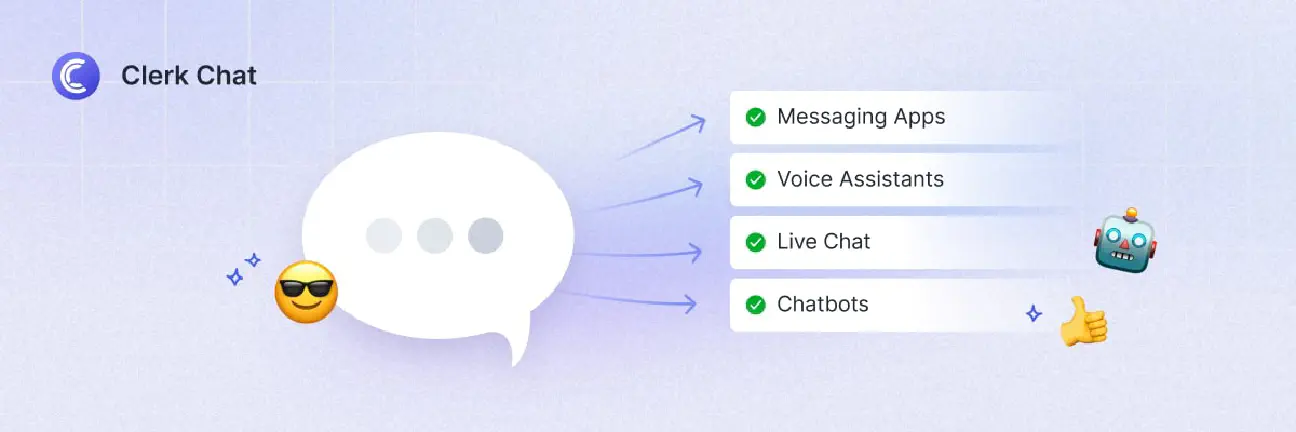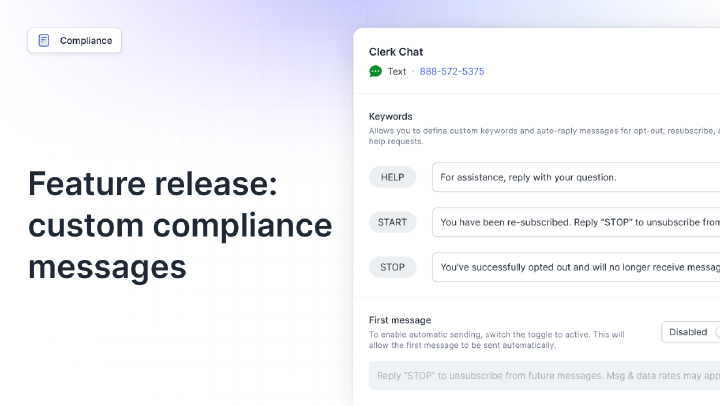What is Conversational Commerce, and How Can It Benefit Your Business?
By Team Clerk Chat
- Published: October 10, 2024
Let’s face it, today’s customers are pretty demanding. They want everything, from high quality products to quick delivery and personalized, convenient service. The right strategy for conversational commerce is just one of the ways you can adapt to customer expectations.
In an environment where more than 80% of customers are willing to pay extra to get a guaranteed great experience, conversational commerce gives you a convenient way to build, improve, and strengthen relationships with customers throughout the buying journey.
Using a combination of conversational AI technology, messaging apps, and data, you can take a personalized, dialogue-driven approach to helping customers understand your brand, make intelligent purchasing decisions, and get the most out of their products.
Here’s your guide to unlocking the benefits of conversational commerce.
What is Conversational Commerce?
So, what is conversational commerce, exactly? Put simply, conversational commerce is a strategy for driving sales that combines ecommerce, technology, and customer conversation. It’s a method of using various tools to create an interactive dialogue and shopping experience for your customers.
With this strategy, companies use a myriad of personalized text messages, AI chatbots, and automated tools to guide customers through every stage of the purchasing process.
Conversational ecommerce brings convenience to the shopper, allowing them to ask questions, make purchases, and stay in touch with companies through messaging tools.
This approach to selling has grown increasingly popular in recent years, thanks to the rise of innovative AI chatbots, changing customer preferences, and new ecommerce technology. In fact, the market for conversational commerce is expected to hit a value of $34.4 billion by 2034.
Conversational Commerce Examples
Conversational commerce experiences can occur during numerous touchpoints throughout the customer journey, leveraging everything from ecommerce platform apps to SMS AI solutions.
Let’s take a look at some conversational commerce examples in practice.
1. Messaging App and SMS Interactions
Customers are tired of calling companies or filling out contact forms and waiting for salespeople to get in touch when they have questions. Increasingly, they’re turning to conversational text messaging solutions and apps like WhatsApp and Messenger to connect with brands in real-time.
These tools allow buyers to exchange messages and data with the companies they’re interested in, complete tasks, and even make purchases with incredible ease.
For instance, through a conversational messaging platform, a hotel group allows customers to book rooms and services, request upgrades, and even ask for recommendations, all with nothing but their smartphone.
2. Live Chat Software
Live chat software, built into ecommerce platforms, allows for a form of convenient 2-way messaging between customers and sales, or service teams. These apps are monitored by human team members who work behind the scenes to answer questions and deliver support to customers.
Sometimes, they can even use Webex texting or Microsoft Teams integrations alongside live chat software, to collaborate with team members on customer requests.
Live chat offers faster, more convenient support to customers, increasing your company’s chances of conversions, and it can be less expensive to manage than a phone-based contact center.
3. Chatbots
Offering an autonomous alternative to live chat, chatbots can deliver 24/7 service to customers, answering questions automatically, without the need for human input. Notably, there is a difference between modern conversational AI and chatbots.
Traditional chatbots were often rule-based programs that could only respond to specific, basic questions, limiting the conversational experience.
AI-based chatbots, leveraging conversational AI in ecommerce, provide a more robust and personalized shopping experience. They can simulate human conversations, personalize experiences, and complete a range of tasks.
For instance, some tech companies use a conversational intelligence platform to ensure customers can access accurate responses to their questions through prompted customer service messaging.
4. Voice Assistants
The evolution of AI algorithms is one of the reasons why conversational commerce has grown so popular in recent years. Today, companies from various industries can go beyond offering AI-based assistance through messaging apps and texts.
They can create intelligent assistants that leverage voice recognition technology and natural language processing to understand spoken words. Voice assistants enable customers to use spoken commands to complete a task, such as requesting information about a product or placing an order.

The Benefits of Conversational Commerce
On a broad level, conversational commerce helps companies to deliver more convenient, humanized, and personalized experiences to customers, across a range of channels. That’s crucial at a time when around 78% of companies say they prefer brands that offer personalized experiences.
Leveraging an SMS service for ecommerce, messaging apps, and cutting-edge AI technology, companies can effectively guide their customers through the purchasing journey.
Used correctly, conversation commerce can:
- Boost engagement: Incorporating conversational commerce into touchpoints like your ecommerce website and social media gives you an easy way to engage your customers throughout their journey. You can even boost engagement post-purchase with transactional text messages and alerts, keeping customers connected to your brand.
- Increase conversion rates: Abandoned baskets are common in the ecommerce industry. Clever interventions from chatbots, AI and proactive notifications can increase the chances of a customer completing their purchase. Some tools even empower you to deliver personalized recommendations to customers, alongside bespoke upsell and cross-selling offers.
- Unlock valuable data: Conversations with customers are a goldmine of valuable data. The more information you collect from discussions with your audience throughout the buyer journey, the easier it is to qualify leads, segment your audience into different groups for future personalization strategies, and increase future revenue.
- Improved customer relationships: Customers want interactions with businesses to feel authentic, personalized, and unique. Conversational commerce helps you gather information to personalize the customer experience, and improve customer experiences. The result is greater loyalty and higher retention rates. In fact, 94% of shoppers say good service makes them more likely to buy from a brand again.
- Enhanced lead generation: With tools for messenger-based and SMS lead generation, you can quickly and effectively introduce large volumes of customers to new products and services, as well as offers and promotions. This not only boosts traffic to your website and products, but reduces the cost of customer acquisition.


4 Steps for a Strong Conversational Commerce Strategy
Conversational commerce is a highly versatile way to increase sales in the digital world. In any industry, it can pave the way to better customer relationships, increased sales, and even reduced operational costs. However, you do need the right strategy.
Here’s your step-by-step guide to getting started with conversational ecommerce.
Step 1: Define Your Goals and Challenges to Overcome
First, define the goals of your conversational commerce strategy. Your primary goal will usually be to drive sales, but it helps to go a little deeper. Think about whether you’re just trying to boost online conversions or improve the customer experience and enhance your brand’s reputation by optimizing every stage of the customer’s journey.
Identifying what you want to accomplish with your strategy will help you determine the metrics you need to monitor throughout your campaigns. For instance, if your goal is to improve customer sales and retention, you’ll track conversion rates, customer churn, and customer satisfaction scores.
As you identify your goals, think about the challenges you may need to overcome, such as:
- Preserving compliance: Different tools and strategies for conversational commerce come with different compliance issues to consider. For instance, if you’re using conversational AI in financial services to interact with customers, you’ll need to think carefully about how you’re securing payments and protecting sensitive data.
- Maintaining the human touch: Not everyone enjoys chatting with bots for everything. Be careful about how much you rely on AI for your strategy. Ensure customers know when they’re talking to a bot and have the option to switch to a human conversation.
- Implementation: Conversational commerce is accompanied by a lot of different technologies and processes. You’ll need to make sure you can align your data from various communication channels, and integrate crucial technologies, such as your Shopify SMS platform, ecommerce tools, and CRM software.
Step 2: Choose your Conversational Commerce Platform
There are various tools that can enable companies to implement a conversational commerce strategy. The right option for you will depend on which communication channels you’re going to be using, your technology ecosystem, and your specific needs.
When assessing your options, look for:
- The right communication tools: Identify whether you’re going to be investing mostly in live chat, SMS, AI chatbots, or social media messaging. Make sure your platform has the tools required to support those communication methods. For instance, if you’ll be using SMS, you’ll need ecommerce SMS templates, automation tools, and SMS analytics.
- Compliance and security: Ensure your chosen platform aligns with your messaging, marketing, or SMS compliance and security strategies. Look for end-to-end encryption, integration with archiving solutions, and comprehensive access controls.
- Integrations: It’s much easier to implement and manage a conversational commerce strategy when all of your tools work effectively together. Look for a platform that integrates with your ecommerce platform, as well as other essential tools. For instance, you may need a HubSpot SMS integration so you can access CRM data to personalize messages.
Solutions like Clerk Chat can offer all of the functionality you need for a robust conversational commerce strategy, from intuitive customizable templates, to conversational AI assistants, and automated workflows. Plus, Clerk Chat offers end-to-end security, as well as integrations for the tools you already use, like our popular Microsoft Teams SMS integration.
Step 3: Define and Implement your Strategy
Once you have your goals, and the right technology, define your strategy for conversational commerce. Identify what kinds of conversations will be handled by bots and humans, across which channels, and how you’ll embed your efforts throughout the buyer journey.
Key moments to think about include:
- Product discovery: During the initial stages of their purchasing journey, customers might interact with AI bots to ask questions about the features of certain products, how long they’ll take to arrive, and more. Advanced AI solutions can even offer suggestions on which products to purchase, based on a customer’s unique goals.
- Conversion: When customers are ready to make a purchase, conversational commerce can enhance the conversion experience. Bots can send payment links to customers on their preferred communication channel, with specialized bundles and offers. They can even provide access to exclusive gift cards and discount codes.
- Post purchase: After a customer makes a purchase, your conversational commerce strategy might include sending an auto reply text to the buyer, letting them know their order has been received, or providing them with a tracking link. You could also send links to onboarding materials and videos to customers, to help them make the most of their purchase.
Step 4: Gather Data and Optimize
Finally, after you’ve implemented your conversational commerce strategy, make sure you monitor the results. Pay attention to how often conversations with your chatbots and AI assistants lead to conversions. Gather data directly from customers with surveys and reviews, asking them for insights into how you can further improve their experience with your company.
The more data you collect about everything from conversion rates and cart abandonment rates, to customer satisfaction scores, the more you’ll be able to improve your strategy, boosting customer loyalty, and enhancing the ROI of your campaigns.
You might even discover that simple updates, such as refining your SMS templates to include extra details or different language, have a direct impact on your profit margins.
Embrace the Age of Conversational Commerce
Conversational shopping, or conversational commerce, is becoming an increasingly valuable tool for today’s brands. It allows you to connect with customers more effectively, access more leads, boost conversions, and earn consumer loyalty.
With a platform like Clerk Chat, you can create frictionless, streamlined, and personalized buyer experiences that drive sustainable growth for your brand.
Our comprehensive solutions for SMS marketing, two-way texting, conversational AI and automation simplify the path to a successful conversational commerce strategy. Contact our team today to learn more, or start experimenting with the Clerk Chat platform with a free demo.
In this article:
Ready to use your business number for text messaging?
Thousands of businesses are already experiencing the power of conversational messaging through SMS. Join us. Free trial and paid tiers available.
Get Started#Subscribe
Get product updates in your inbox
Tutorials, features, and Clerk Chat news delivered straight to you.




